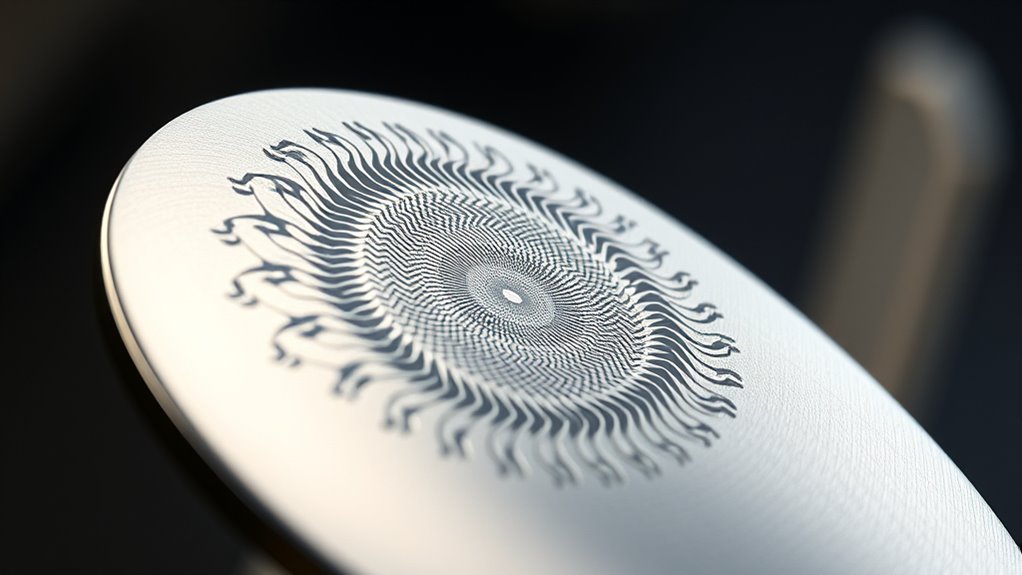Fractals can revolutionize wireless antenna design by allowing you to create compact, multi-band antennas that deliver high efficiency without increasing size. Their self-similar patterns naturally support multiple resonant frequencies, making devices more versatile and capable of seamless communication across different networks like Wi-Fi, 4G, and 5G. By leveraging fractal geometries, you can develop antennas that are smaller, more reliable, and better suited for modern technology—if you continue exploring, you’ll discover how these patterns shape the future of wireless connectivity.
Key Takeaways
- Fractals enable multi-band operation within a compact footprint, supporting diverse wireless frequencies.
- Their self-similar patterns enhance electromagnetic interaction at multiple scales, improving efficiency.
- Fractal antennas achieve miniaturization without sacrificing performance, making devices smaller and lighter.
- The complex geometries allow for multiple resonance modes, boosting multi-frequency capabilities.
- Integration of fractal designs drives innovation in compact, high-performance wireless communication devices.

Have you ever wondered how modern wireless antennas can be so compact yet highly effective? The secret lies in innovative design techniques like antenna miniaturization, which allow antennas to fit into small spaces without sacrificing performance. One of the key principles behind this is signal resonance. When an antenna resonates at a specific frequency, it efficiently transmits and receives signals, maximizing performance even in limited space. Traditional antennas often struggle to maintain resonance at multiple frequencies, leading to bulky designs or subpar performance. However, fractals offer a game-changing solution by enabling antennas to resonate across a broad range of frequencies within a tiny footprint.
Fractal geometries are intricate, self-similar patterns that repeat at different scales. By integrating these patterns into antenna design, engineers can create structures that naturally support multiple resonant frequencies. This means a single fractal antenna can operate effectively over various bands, reducing the need for multiple antennas and cutting down on size. This process, known as antenna miniaturization, becomes considerably more efficient with fractals because their complex shapes inherently support multiple modes of resonance. As a result, your devices can be smaller, lighter, and more versatile without compromising signal strength or quality.
Fractal patterns enable multi-band, compact, and efficient antenna designs for modern wireless devices.
Additionally, the unique properties of fractal antennas allow for better control over signal resonance. The self-similar patterns enable the antenna to interact with electromagnetic waves at different scales, enhancing its ability to pick up or emit signals across a wide spectrum. This multi-band capability is particularly valuable in today’s world, where devices need to connect seamlessly across various networks like Wi-Fi, 4G, 5G, and beyond. The fractal design also reduces antenna size without increasing losses or degrading signal quality, which is a common challenge with traditional miniaturized antennas. Moreover, the integration of fractal geometries can improve the overall antenna efficiency, making the devices more reliable and energy-efficient.
You benefit from this technological evolution as a user because your smartphones, IoT devices, and wearable tech can become more compact and efficient. Fractal antennas help meet the demands for smaller, more powerful gadgets that can handle multiple frequencies simultaneously. As research advances, expect to see even more innovative uses of fractals in wireless communication, pushing the boundaries of antenna miniaturization and resonance control. This intersection of mathematics and engineering isn’t just making devices smaller; it’s revolutionizing how they connect, communicate, and perform in an increasingly wireless world.
Frequently Asked Questions
Can Fractal Antennas Be Used for All Wireless Communication Frequencies?
You wonder if fractal antennas work across all wireless communication frequencies. They offer impressive frequency versatility because their complex shapes enable multi-band operation, making them suitable for various signals. Additionally, they are compatible with different materials, enhancing material compatibility. However, their efficiency may vary depending on the specific design and application. Overall, fractal antennas provide a flexible, adaptable option for many wireless communication needs, but you should consider particular requirements for ideal performance.
How Do Fractal Shapes Affect Antenna Manufacturing Costs?
Fractal shapes can impact your antenna manufacturing costs by increasing manufacturing complexity due to their intricate designs. These designs often require specialized tools and precise fabrication, which can raise material costs and production time. However, their efficiency across multiple frequencies might offset these costs in the long run. So, while initial expenses may be higher, the overall benefits could make fractal antennas a cost-effective choice for your wireless applications.
Are There Limitations to Using Fractals in Antenna Miniaturization?
You might wonder if there are limitations to using fractals in antenna miniaturization. While fractals enable compact designs, they also increase manufacturing complexity and introduce design constraints. Precise fabrication becomes challenging as fractal details grow smaller, potentially affecting performance. These factors can limit how much you can miniaturize antennas with fractals, requiring careful balance between size reduction and maintaining efficiency and reliability in your designs.
What Environmental Factors Impact Fractal Antenna Performance?
Imagine your fractal antenna as a delicate leaf in a storm, vulnerable to weather interference like rain or wind that can distort signals. Environmental factors such as weather interference can weaken performance, while material durability determines how well it withstands harsh conditions. You need robust materials and protection to guarantee your antenna remains resilient, maintaining clear communication even when nature throws its worst at you.
Can Fractal Antenna Designs Be Integrated With Existing Technologies Easily?
You can definitely integrate fractal antenna designs with existing technologies, but it requires careful design integration and addressing manufacturing challenges. Fractal antennas often need specialized fabrication techniques, which might increase complexity or cost. However, with proper planning and advanced manufacturing methods, you can overcome these challenges, making it easier to incorporate fractal antennas into current wireless devices for improved performance and multi-band capabilities.
Conclusion
By now, you can see how fractals are like a secret code revealing better antenna designs. Their unique patterns let your antennas reach further and perform better, just like a finely tuned instrument. Imagine your wireless device as a lighthouse, shining its signal far and wide, thanks to fractal innovation. Embracing fractals could turn your communication tech into a marvel of efficiency, making your connections stronger and more reliable—like a symphony where every note hits perfectly.










